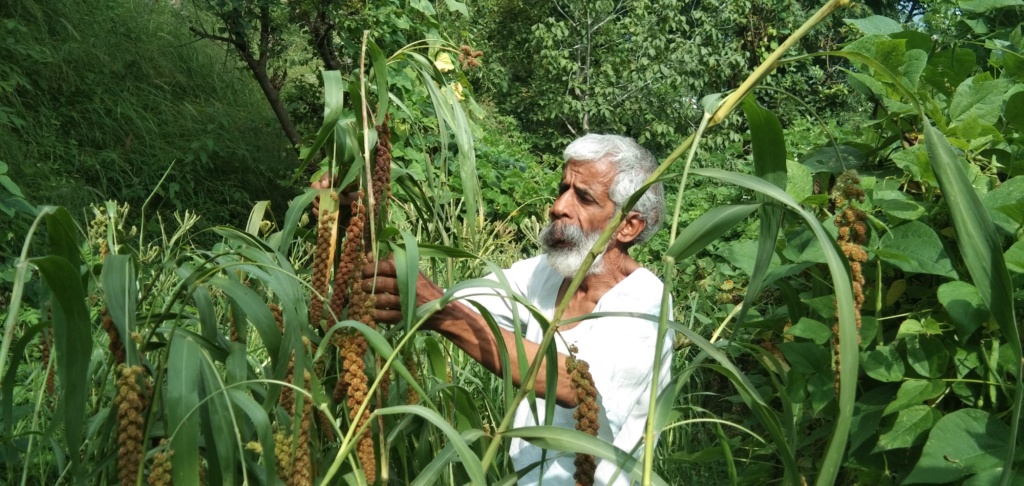Vijay Jardhari founded the Beej Bachao Andolan to spread the message on sustainable farming

First published: https://www.livemint.com/mint-lounge/features/lounge-heroes-leading-the-sustainable-agriculture-fightback-11599801316227.html
Lounge Heroes | Leading the sustainable agriculture fightback
Vijay Jardhari, 68, farmer and environmental activist led a movement among Uttarakhand’s farmers to revive sustainable agricultural practices like crop rotation and boost food security
By the late 1980s, farming practices in India had undergone drastic change. The government was handing out high-yielding variety seeds, artificial fertilizers and pesticides to farmers at a marginal cost. At the time, most farmers considered it to be a blessing.
It was no different in the hills of present-day Uttarakhand, where the government was encouraging the cultivation of soya bean.But as time passed, the dependence on a single crop began to take a toll on lives, livelihoods and the soil. And in 1986, environmental activist and farmer Vijay Jardhari, now 68, launched the Beej Bachao Andolan to preserve local seeds and encourage indigenous farming methods.
“The crop production had increased in the first couple of years and everyone celebrated the success. But over time we could see that the quality of the soil was degrading due to the chemical fertilizers,” Jardhari says, perched outside his workspace, which overlooks the green fields of Nagni in Tehri Garhwal.
The region used to be renowned for its sustainable farming practices, passed down generations. It believed in crop rotation, mixed crop farming, and the use of natural products as manure. Every farmer kept animals—the milk offered nutrition for the family and the dung was used for manure. Most farmers were self-sufficient, bartering the surplus produce or simply selling it in the market.
All this changed. For, while soya bean could fetch a fair price, locals now had to buy essential grains and pulses for consumption—earlier, they would just grow these in their own fields.
“Before soya bean, our fields were providing food for us, while the by-products were fodder for the domesticated animals. I soon realized that in case of crop failure, we would have neither money nor food to survive,” Jardhari recalls.
Jardhari had been part of the Chipko Andolan, which successfully protested the haphazard destruction of forests, in the 1970s. By 1984, his comrades and he were battling illegal mining in the region. But though activism was an integral part of his life, Jardhari remained a farmer at heart. And the next cause he took up was linked closely to his daily subsistence.
When Jardhari and others who worked with Beej Bachao Andolan consulted village elders, they realized the change in farming practices wasn’t the only problem: Nutritious indigenous crops, such as millet, had been edged out completely.
“We set out for remote, interior villages of Uttarakhand in order to collect seeds and created a bank. No scientist or member of the agriculture department had ever visited these places before. Once we had gathered enough seeds, we started giving them out to farmers,” he says.
In 1988, the team marched on foot from Arakot in Uttarkashi to Askot in Pithoragarh—a distance of over 600km—distributing seeds and spreading the word on reviving sustainable practices in farming pockets across the state. They encouraged farmers to revive the crop rotation system known as Bara Anaaj—a farming cycle that involves 12 different seeds. For, cultivating a variety of crops not only ensured a constant supply of food through the year, it also allowed the soil to breathe between cycles.
“The earth is a living being and it needs a holiday just like the rest of us,” says Jardhari, smiling. “We call her Mother Earth but don’t respect her. The rotation is great for the soil and keeps it healthy.”
Within a few months, they collected 350 varieties of seeds from farmers around Uttarakhand, including 220 types of rajma (kidney bean), 12 varieties of mandwa (finger millet), eight varieties of jhangora (barnyard millet), over 30 varieties of wheat, and four-six varieties of jowar (sorghum). They organized workshops to educate farmers on the need to keep cultivating these local crops.
“This is not my concept—people have been practising this for years. Out attempt was only to get people to realize that traditional farming was more sustainable in the long run as compared to other methods,” he says.
Things didn’t always go smoothly. There were occasions when the gram sabhas would accuse Jardhari of misguiding farmers. A few farmers scoffed, arguing he was against progress. But time and again the critics were proved wrong—for whether it was the droughts of 1986 and 2009, or the heavy rain of 2010-11, crops such as mandwa, jhangora, kauni and chaulai survived. Even in the worst of times, farmers were able to grow enough to feed their families and sell some produce in the market.
“If you see, in places where suicides are being reported, farmers have taken to growing a single crop,” Jardhari says.
Local crops tend to be both hardy and nutritious, easy to grow since they need less water. For though Uttarakhand may have glacier-fed river systems, farmers high up in the mountains still depend on monsoon rain for cultivation. So the crops are carefully selected to ensure they do not require too much water. In addition, “millet, for instance, has the highest nutrition value and those who consume it have few illnesses”, says Jardhari.
“Monetary packages for farmers are not going to end suicides. We need to bring back the values of farming, keeping in mind the changing weather pattern, and act accordingly,” he says.